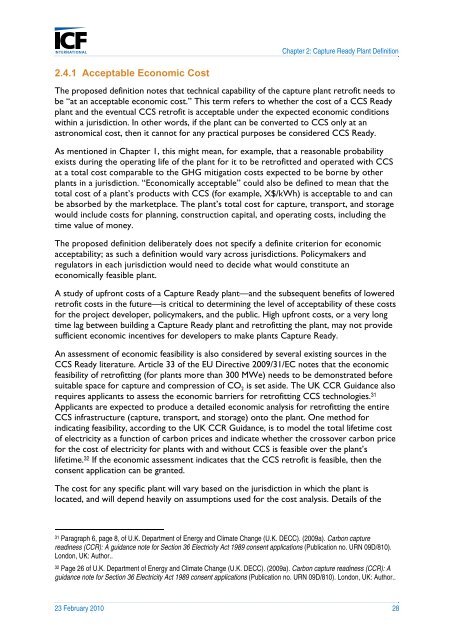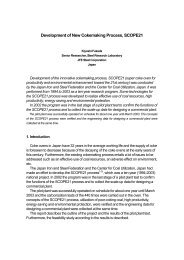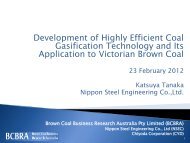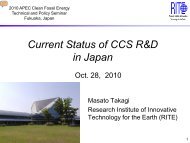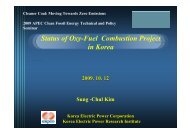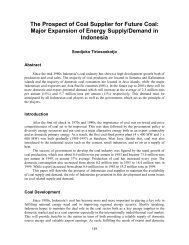Defining CCS Ready: An Approach to An International Definition
Defining CCS Ready: An Approach to An International Definition
Defining CCS Ready: An Approach to An International Definition
- No tags were found...
You also want an ePaper? Increase the reach of your titles
YUMPU automatically turns print PDFs into web optimized ePapers that Google loves.
Chapter 2: Capture <strong>Ready</strong> Plant <strong>Definition</strong>2.4.1 Acceptable Economic CostThe proposed definition notes that technical capability of the capture plant retrofit needs <strong>to</strong>be “at an acceptable economic cost.” This term refers <strong>to</strong> whether the cost of a <strong>CCS</strong> <strong>Ready</strong>plant and the eventual <strong>CCS</strong> retrofit is acceptable under the expected economic conditionswithin a jurisdiction. In other words, if the plant can be converted <strong>to</strong> <strong>CCS</strong> only at anastronomical cost, then it cannot for any practical purposes be considered <strong>CCS</strong> <strong>Ready</strong>.As mentioned in Chapter 1, this might mean, for example, that a reasonable probabilityexists during the operating life of the plant for it <strong>to</strong> be retrofitted and operated with <strong>CCS</strong>at a <strong>to</strong>tal cost comparable <strong>to</strong> the GHG mitigation costs expected <strong>to</strong> be borne by otherplants in a jurisdiction. “Economically acceptable” could also be defined <strong>to</strong> mean that the<strong>to</strong>tal cost of a plant’s products with <strong>CCS</strong> (for example, X$/kWh) is acceptable <strong>to</strong> and canbe absorbed by the marketplace. The plant’s <strong>to</strong>tal cost for capture, transport, and s<strong>to</strong>ragewould include costs for planning, construction capital, and operating costs, including thetime value of money.The proposed definition deliberately does not specify a definite criterion for economicacceptability; as such a definition would vary across jurisdictions. Policymakers andregula<strong>to</strong>rs in each jurisdiction would need <strong>to</strong> decide what would constitute aneconomically feasible plant.A study of upfront costs of a Capture <strong>Ready</strong> plant—and the subsequent benefits of loweredretrofit costs in the future—is critical <strong>to</strong> determining the level of acceptability of these costsfor the project developer, policymakers, and the public. High upfront costs, or a very longtime lag between building a Capture <strong>Ready</strong> plant and retrofitting the plant, may not providesufficient economic incentives for developers <strong>to</strong> make plants Capture <strong>Ready</strong>.<strong>An</strong> assessment of economic feasibility is also considered by several existing sources in the<strong>CCS</strong> <strong>Ready</strong> literature. Article 33 of the EU Directive 2009/31/EC notes that the economicfeasibility of retrofitting (for plants more than 300 MWe) needs <strong>to</strong> be demonstrated beforesuitable space for capture and compression of CO 2 is set aside. The UK CCR Guidance alsorequires applicants <strong>to</strong> assess the economic barriers for retrofitting <strong>CCS</strong> technologies. 31Applicants are expected <strong>to</strong> produce a detailed economic analysis for retrofitting the entire<strong>CCS</strong> infrastructure (capture, transport, and s<strong>to</strong>rage) on<strong>to</strong> the plant. One method forindicating feasibility, according <strong>to</strong> the UK CCR Guidance, is <strong>to</strong> model the <strong>to</strong>tal lifetime cos<strong>to</strong>f electricity as a function of carbon prices and indicate whether the crossover carbon pricefor the cost of electricity for plants with and without <strong>CCS</strong> is feasible over the plant’slifetime. 32 If the economic assessment indicates that the <strong>CCS</strong> retrofit is feasible, then theconsent application can be granted.The cost for any specific plant will vary based on the jurisdiction in which the plant islocated, and will depend heavily on assumptions used for the cost analysis. Details of the31 Paragraph 6, page 8, of U.K. Department of Energy and Climate Change (U.K. DECC). (2009a). Carbon capturereadiness (CCR): A guidance note for Section 36 Electricity Act 1989 consent applications (Publication no. URN 09D/810).London, UK: Author..32 Page 26 of U.K. Department of Energy and Climate Change (U.K. DECC). (2009a). Carbon capture readiness (CCR): Aguidance note for Section 36 Electricity Act 1989 consent applications (Publication no. URN 09D/810). London, UK: Author..23 February 2010 28


